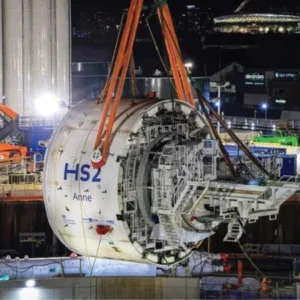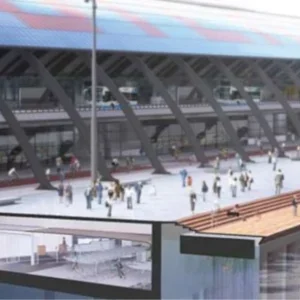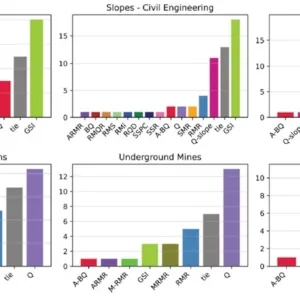Whilst not too problematical on a canal or sewer system, leakage into a rail tunnel damages signaling equipment and causes corrosion to rails and overhead catenary.
If controlling or diverting ingress from over the tunnel crown can be achieved, it may be sufficient to overcome such damaging effects.
Remedial methods include fixing plastic membranes or corrugated sheets to the intrados, applying cementitious coatings, cement grouting behind the lining or resin injection into the brickwork. Internal physical barriers have several drawbacks and need maintaining, grouting behind the lining increases the load on the tunnel and may not seal active water flow paths. Since ingress predominantly occurs through open mortar courses, injecting brickwork with resin to fill flow paths appears to be a logical remedy. However, as with many civil engineering remedial situations, success is reliant on experienced, knowledgeable engineers selecting appropriate materials and devising logical work protocols. Get these wrong and any form of injection will be ineffective.
Two injection resins are commonly offered for leak-sealing – hydrophilic or hydrophobic, both are polymers. Hydrophilic resins are two-component, low viscosity liquids (typically acrylic) that react to form a gel, hydrophobic resins are mostly single-component polyurethane that are injected to make contact with leak water. On contacting water, the resin reacts to form cellular foam, both gel and foam block water flow paths and so control leakage. Of the two, hydrophobic polyurethane foam is more suitable for controlling leakage through brick linings than hydrophilic gels. The rationale is found in resin rheology, fluid dynamics, polymer flow, shear thinning, viscosity, pseudoplastic flow, molecular chain disentanglements, and other factors.
Site experience affirms the benefit of injecting hydrophobic polyurethane resin, free water inflows are arrested and dripping reduced, and overall injected sections visibly start to dry out.
A monitoring system exists for assessing the efficacy of resin injection into brick tunnels, the work area is surveyed before works commence and an assessment of ingress made and recorded. The evaluation is by objective observation against a Network Rail (The British railway infrastructure operator) scale of W1 to W5 using the following standards:
W1 = water ingress under pressure
W2 = water running
W3 = water dripping
W3i = isolated drips
W4 = damp
W5 = water staining
On a typical project, an inspection some two and a half weeks after injection confirmed that ingress had been reduced typically from W4 to W4/5 up to W2 to W4/5. A further inspection two years later endorsed the injection as effective. W4 on the leakage scale is the target value set by Network Rail to declare the injection process a success.
A successful result is not simply a matter of injecting a hydrophobic resin but is a comprehensively engineered solution. For example, as known proprietary injection resins were considered unsuited for use in a wet rail tunnel environment, a bespoke product was formulated, developed and tested. Given the brand-name Stabila P500, the new resin reacts to form a tough, flexible closed cell foam with a gentle reaction that inhibits delamination of brick courses. Stabila P500 was subsequently accepted by the UK Drinking Water Inspectorate for use in contact with potable water. Following accelerated testing of polyurethane foam in an alkaline environment, the life expectancy is extrapolated to be in excess of 75 years.
On a typical tunnel sealing project, 14mm-diameter injection ports are drilled in the brickwork by rotary percussive drills. Port spacing is calculated to provide resin spread through the open mortar courses between adjacent injection ports. Drilling is generally perpendicular to the intrados face and port depth relates to the number of brick courses, typically two thirds of the overall brick thickness. As the condition and uniformity of brickwork varies and customarily deteriorates at higher levels over the crown, the injection engineer may occasionally authorise a modified drilling pattern to substantially weakened sections. Injection packers featuring expanding rubber seals are then inserted and normally set in the second brick course.
On injecting Stabila P500, water ingress throughout the work section visibly changes. Previously running inflows are arrested, dripping essentially stops and generally the area starts to dry out.
Injection is by air-powered piston pumps with pump pressure accurately controlled to slightly above pump stall pressure and just sufficient to overcome resistance in the injection lines. High pressure or high resin flow-rates are not necessary and may be detrimental to the structure. As distinct from cement grouting, resin injection protocol is not designed to ‘grout to refusal’, therefore peak pressure does not apply.
Void sizes in the mortar course directly affect the volume of resin injected to control ingress and such voids cannot be predetermined or quantified. The grouting procedure is monitored in real time to evaluate the grout flow over an area and the influence achieved. Resin take per injection port is not a constant value as open mortar course dimensions vary; such variation may lead to localised secondary and tertiary injection in some situations.
In conclusion, resin injection can be extremely successful in controlling water ingress through complicated water flow paths. However, understanding the concepts of comprehensively engineered protocols and appropriate injection resin requires a sound knowledge of the principles involved coupled with an empirical approach; unfortunately these are not gained in a classroom but learned through applied logic and experience.
Working with a rail trolley access platform in leak remedial work Inspecting for any remaining seepage following installation of polyurethane resin through the packers shown Schematic of an injection packer






